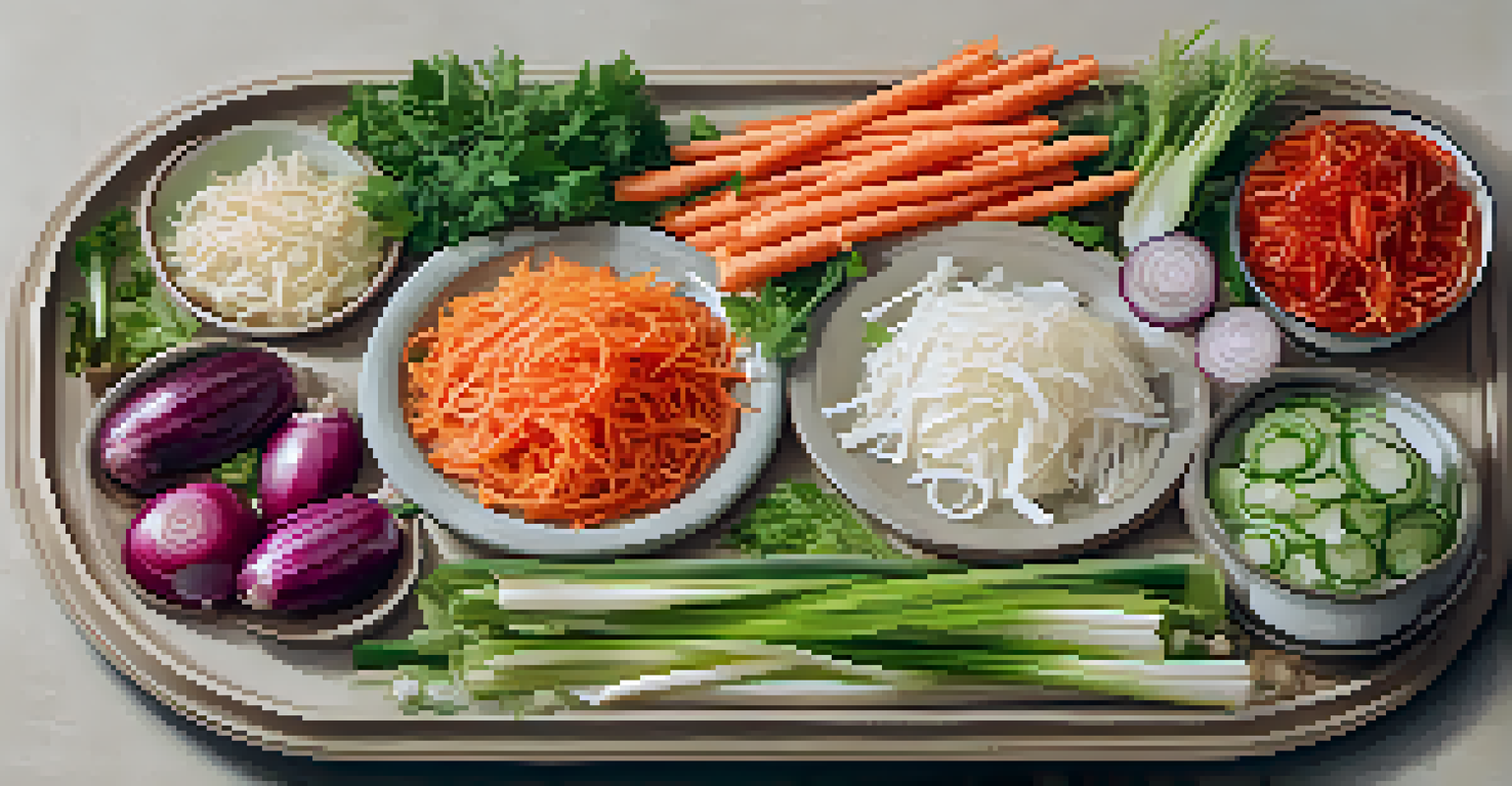Incorporating Fermented Foods into Raw Diet Plans

Understanding Fermented Foods and Their Benefits
Fermented foods are created through the process of fermentation, where natural bacteria break down sugars and starches. This process not only preserves the food but also enhances its nutritional value. Foods like kimchi, sauerkraut, and yogurt are prime examples, packed with probiotics that support gut health.
Food is not just fuel; it's information. It talks to your DNA and tells it what to do.
Incorporating these foods into your diet can lead to better digestion, improved immunity, and even enhanced mood. Think of probiotics as little helpers working to keep your gut flora balanced, much like how a gardener tends to a thriving garden. A healthy gut can influence overall well-being in remarkable ways.
Combining fermented foods with a raw diet can create a powerhouse of nutrients. It’s like pairing two superheroes to tackle your health goals—together, they offer a unique blend of vitamins, minerals, and beneficial bacteria that can elevate your eating experience.
Why Raw Diets Benefit from Fermented Foods
Raw diets focus on uncooked, unprocessed foods, which are rich in enzymes and nutrients. However, these diets can sometimes lack sufficient probiotics. By adding fermented foods, you fill in the gaps, ensuring your digestive system is supported while enjoying the raw benefits.

Fermented foods can also introduce unique flavors and textures to your meals, transforming a simple salad into a culinary delight. Imagine adding tangy sauerkraut to a fresh coleslaw—suddenly, you have a dish that’s not just nutritious but also bursting with flavor.
Fermented Foods Enhance Nutrition
Incorporating fermented foods like kimchi and yogurt into your diet can improve digestion, immunity, and mood.
Moreover, the fermentation process enhances the bioavailability of certain nutrients, making them easier for your body to absorb. This means you’re getting more nutritional bang for your buck, which is especially important when you’re following a raw diet.
Simple Ways to Incorporate Fermented Foods
Starting to include fermented foods into your raw diet can be as easy as adding a few spoonfuls of sauerkraut to your salads or bowls. You might also try incorporating kimchi into your wraps or sandwiches for a spicy kick. The beauty of these foods is their versatility; they can complement many dishes effortlessly.
The gut is the seat of all health; it is where we receive nourishment from our food and where many health issues begin.
Smoothies are another fantastic way to incorporate fermented foods. Consider adding a scoop of kefir or a tablespoon of miso to your morning blend for an extra boost of flavor and nutrition. It’s like inviting a new friend into your breakfast routine who brings exciting stories and health benefits.
Don't forget about making your own fermented foods at home! Simply try your hand at fermenting vegetables or creating your own yogurt. It can be a fun, rewarding experience that connects you to your food, and it allows you to tailor the flavors to your liking.
Pairing Fermented Foods with Raw Ingredients
Pairing fermented foods with raw ingredients can create a delightful balance of flavors and nutrients. For instance, consider combining fresh veggies with a dollop of yogurt dressing, bringing together the crunch of raw produce with the creamy, tangy taste of fermentation. This contrast can elevate your meals from ordinary to extraordinary.
You can also experiment by adding fermented foods to your raw snacks. Think raw veggie sticks dipped in miso-based dressings or a fermented salsa served with crisp cucumber rounds. It’s a delightful way to enjoy healthy snacks without sacrificing flavor.
Pairing for Flavor and Health
Combining fermented foods with raw ingredients creates a delightful balance of flavors while boosting nutritional benefits.
Moreover, don't hesitate to mix and match different fermented foods. A bowl of raw veggies topped with kimchi, drizzled with a tahini and miso dressing, can create a delicious experience that excites the palate while nourishing the body.
Exploring Fermented Beverages in Raw Diets
Fermented beverages, like kombucha and kefir, can be refreshing additions to your raw diet. These drinks are not only thirst-quenching but also loaded with probiotics, making them a perfect companion for your meals. Imagine sipping on a cool, tangy kombucha while enjoying a fresh salad—what a delightful way to hydrate and nourish!
Incorporating these beverages can also help diversify your diet. With so many flavors available, from fruity to herbal, there’s something for everyone. It’s like having a little adventure in every sip, discovering new tastes that complement your meals beautifully.
Additionally, making your own fermented drinks at home can be a fun project. With just a few ingredients, you can create your own fizzy, probiotic-rich beverages, tailoring them to your tastes and ensuring they fit perfectly into your raw diet.
Staying Mindful of Portions and Ingredients
While fermented foods are healthy, it's essential to be mindful of portion sizes. Too much of a good thing can sometimes lead to digestive discomfort, especially for those new to fermentation. Starting with small amounts and gradually increasing can help your body adjust to the influx of probiotics.
Also, pay attention to the ingredients in store-bought fermented foods. Some products can contain added sugars or preservatives that detract from their health benefits. Reading labels can be your best friend, ensuring that what you’re consuming aligns with your raw diet principles.
Mindful Consumption is Key
It's important to watch portion sizes and read labels on fermented foods to maximize health benefits and avoid discomfort.
Lastly, listen to your body. Everyone's digestive system is unique, and what works for one person might not work for another. Keeping a food journal can help you monitor how different fermented foods make you feel, allowing you to fine-tune your diet for optimal well-being.
Creative Recipes to Try with Fermented Foods
Getting creative in the kitchen can be one of the most enjoyable aspects of incorporating fermented foods into your raw diet. Try making a raw zucchini noodle salad topped with a spicy kimchi and sesame oil dressing. It’s a colorful dish that’s as pleasing to the eye as it is to the palate.
Another idea is to create a fermented fruit salad by adding a splash of lemon juice and a scoop of yogurt or kefir over fresh berries. This combination not only enhances the flavor but also provides a refreshing, probiotic-rich dessert that feels indulgent yet healthy.

Don’t shy away from experimenting with fermented foods in unexpected ways, like adding pickled veggies to a raw sushi roll or using fermented pesto on a raw pizza crust. The possibilities are endless, making every meal an exciting opportunity for culinary exploration.